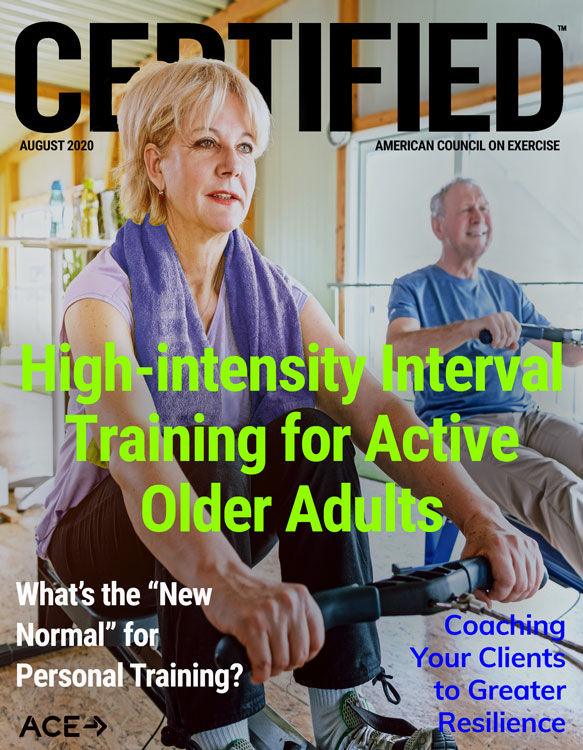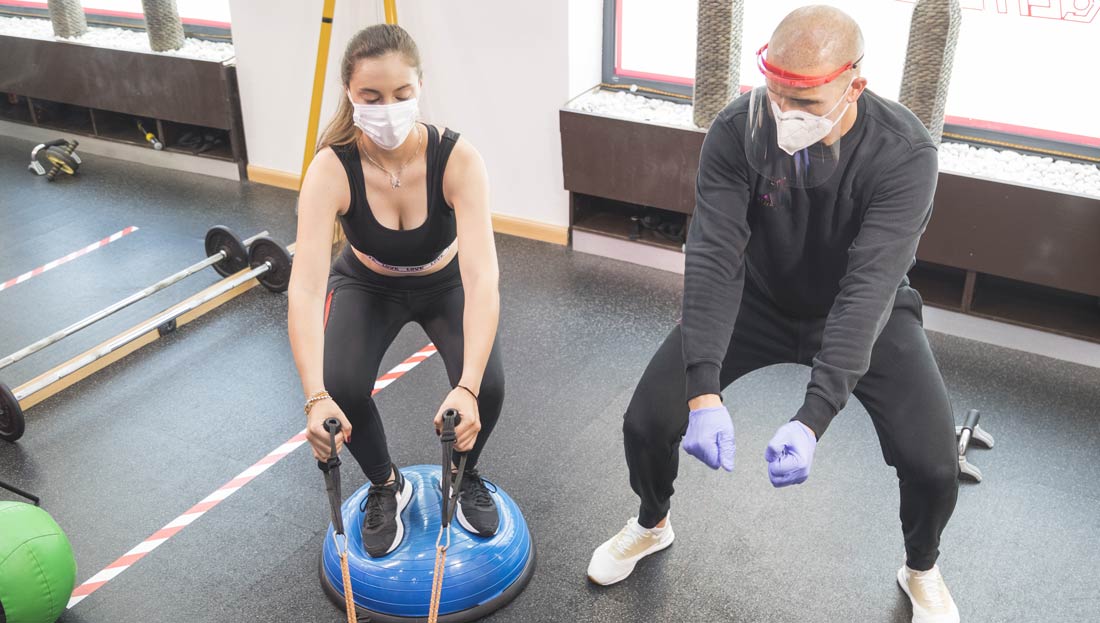
Many gyms are still closed or have opened in limited ways. Many clients are still sequestered in lockdown, or only tentatively making their way back out. And, like many other health and exercise professionals, you may be wondering: How do I rebuild my business?
“You have to be prepared to go where they are, comfort wise,” says Robert Morea, co-owner of Great Jones Fitness in Manhattan. “That’s our new normal in the personal-training business."
Meaning, you have to be able to make your clients feel comfortable about training again—in the gym, in their homes, virtually, outdoors, wherever. “With some of my clients, we need to be wearing gloves and masks in order for them to be comfortable,” says Morea, “And, of course, we wipe down all the equipment we use after each set.”
Touching them is also…well, a touchy subject. “Some clients, don’t care,” says Morea. “But we practice social distancing, we don’t spot them, we keep 6 feet away and instruct them.” While some exercise professionals and clients may feel comfortable with spotting when necessary, you can also minimize the need for spotting by selecting exercises where it isn’t required and providing excellent verbal cues instead of touch cues.
Some health and exercise professionals have kept their businesses going with virtual or outdoor sessions. If you haven’t already transitioned into that kind of training, it’s time to learn how—ACE offers numerous resources on how to train remotely. You might also want to think about where and how you can offer outdoor sessions, and consider purchasing the kinds of portable equipment—bands, TRXs, balls—around which these types of workouts can be built.
Part of your job in this new normal might be offering support, validating a lack of readiness, and providing information to clients as they weigh the pros and cons of getting back into training again. “It’s time to re-educate,” says Morea who, during the lockdown in New York, was able to continue training clients virtually and outdoors.
Supporting Your Clients as They Get Back to Training—and Better Health
While there is much we still don't know about the virus, one thing is clear: Underlying risk factors, such as diabetes and heart disease—conditions that can be prevented or even reversed by following a healthy lifestyle—seem to greatly increase the risk of suffering a severe illness. “If this is not an alarm bell for why you need to take care of yourself, I don’t know what is,” asserts Morea.
Sherry Pagoto, PhD, offers these suggestions on communicating with your clients in the post-COVID environment. Dr. Pagoto is a licensed clinical psychologist and professor in the Department of Allied Health Sciences at the University of Connecticut.
Be on point with your personal behaviors. “As a trainer, I would always wear the mask and I might have some hand sanitizer visible in a pocket. You want to model any behavior you think clients are going to want to see in order to feel protected.”
Practice your verbal cueing. In the new socially distanced or virtual world of training, you will have to rely more on your verbal cueing to guide clients. Preparation for that is important. “I would try out different instructions with friends or family members. That’s what we do as psychologists. When we come up with questions we want to pose to clients, we’ll grab a small number of people to try them out first. [For example,] ‘When I said that, what did it mean to you? Was it clear? Did you have to think about it?’ And then we’ll modify. You should do the same thing with your descriptions of the exercises. Make sure your verbal instructions are clear.”
Stress safety. You may find some clients want to engage in a conversation, maybe even a debate, about the government's response to the virus, mask usage and so forth. “You don’t need to get into an argument; perhaps just say, ‘I interact with the public, so I’m playing it as safe as possible. The worst-case scenario of playing it safe is I’ve worn a mask for no reason. The worst-case scenario of not playing it safe is that someone gets sick.’”
Clients’ opinions count! “Check in with your clients as you lay the ground rules for returning to training and remind them that you are flexible. ‘Would you like to come back, and if so, under what circumstances?’ Or, ‘Does this feel like a good set-up in terms of infection risk? If not, we can adjust.’ We want people to be comfortable as they ease back to the new normal of training.”
What clients might also need to lure them back to training is a little simpler: Something new.
MetroFitness in Montgomery, Ala., reopened in early May. In the months since, general manager Leigh Anne Bolling Richards has noticed something about her staff trainers that she calls “super-interesting.”
“I have one trainer who is a movement specialist,” she says. “He’s very much about training the movement.” Another, she says, has a certification in corrective exercise. “He looks at how you’re doing a squat, and says, ‘Oh, I see why your knees might be hurting.’” A third has introduced active isolated stretching into his sessions with clients.
All three, she says, have been doing brisk business since re-opening; attracting both new and current clients.
But then there’s the trainer who, Bolling Richards says, “was our top producing trainer in March. Right now, she’s not even training. None of her clients have come back.”
The reason, believes Bolling Richards, is that the trainer has continued to offer the same workouts she did prior to lockdown. With so many workouts available online (both free and fee-based), many of her clients likely discovered that they could get the same types of workouts at home without the need to pay a trainer or visit a gym or health club. Conversely, the other trainers are helping their clients solve problems or issues they may be having with their bodies, which has encouraged them to come back to the gym—and to their trainers.
The lesson? In this new reality, health and exercise professionals can’t keep doing the same things they were doing before and automatically expect to be as successful as they once were. The world has changed,” says Bolling Richards, “and if [people are] going to come back to the gym, maybe they want their workouts to change with it.”
Experienced trainers know that what clients want can vary. Especially now. This has been a time of wrenching and often frightening change for so many. While you may not have seen them in person the past few months, have you taken the time to check in with these folks and see how they’re doing?
“For most trainers, their clients become like family,” says personal trainer and studio owner Anna Woods of Buhler, Kan. Even when they cancelled their training sessions during the depths of the pandemic in her state, Woods says, “I tried to maintain as much personal contact with them as possible, via text or phone.”
In her informal communications with her clients, Woods, a mother of three and creator of the sheStrength app, queried them on their motivations and expectations. Did they envision a return to training? Under what conditions? From her informal survey, she learned that while her clients had some concerns about returning to a gym environment, they were ready to get to get back to regular exercise. “They were missing their workouts, they had zero motivation to do it home," she said. “They were eager to get back to a routine.”
Woods was there to provide the guidance they needed, and to help them transition back to training in whatever way it felt comfortable: In her studio, virtually or outdoors.
Finding the Good—and the Opportunity—in the New Normal
The fact that these modalities now exist beyond the classic gym setting can be seen as an opportunity—and not just in the short-term.
“What this time has done has given the fitness industry tremendous insight into the consumer,” says award-winning trainer Todd Durkin, owner of Fitness Quest 10 in San Diego. “I do believe people will come back to the gym; but instead of three times a week, they might do one or two sessions with trainer, and one online.”
Less client time in the gym is not necessarily a bad thing for personal trainers. “It’s been proven the last few months that you can do well in the virtual world, if you learn and are willing to make some mistakes,” Durkin says.
The biggest mistake right now, he thinks, would be to do nothing and simply go back to what you were doing before this. “I think right now is a great time for a trainer to look at business and life as a blank canvas,” says Durkin, whose new book (co-written with Mike Yorkey) is Get Your Mind Right: Ten Keys to Unlock Your Potential and Ignite Your Success. “What do you want to create for your life for the next three to five years? Do you want to train 20 or 30 sessions a week at a studio? Or do you want to explore new options for reaching people and growing your business?"
Expand Your Knowledge
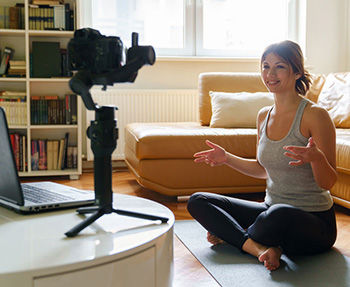
Alternative Ways to Continue Serving Clients During COVID-19
How can you continue to serve your clients when a pandemic has turned the world upside down? This article describes how to identify the best ways to serve each individual client by using open and honest communication and being flexible and creative with your programming, while also keeping your clients—and yourself—safe.
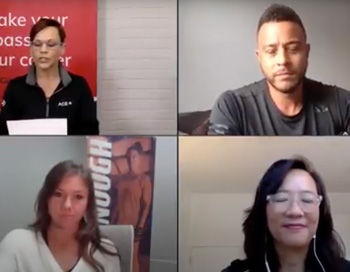
Take Your Training and Coaching Online: Panel Discussion
This webinar features an engaging discussion with a panel of experts in online coaching to help you quickly convert your business and revenue to an online service model.
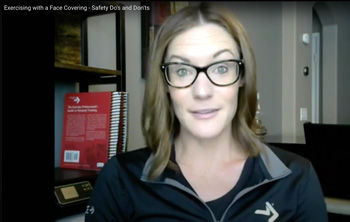
Exercising With a Face Covering: Safety Dos and Don’ts
Face coverings and masks are becoming safety tools for health and exercise professionals as well as fitness enthusiasts working out among fellow devotees in exercise clubs. Watch this conversation between ACE President and Chief Science officer Dr. Cedric Bryant and renowned researcher Dr. Len Kravitz to learn more about what face coverings can and cannot do and how to use them properly to maximize their effectiveness for both you and your clients.





 by
by 